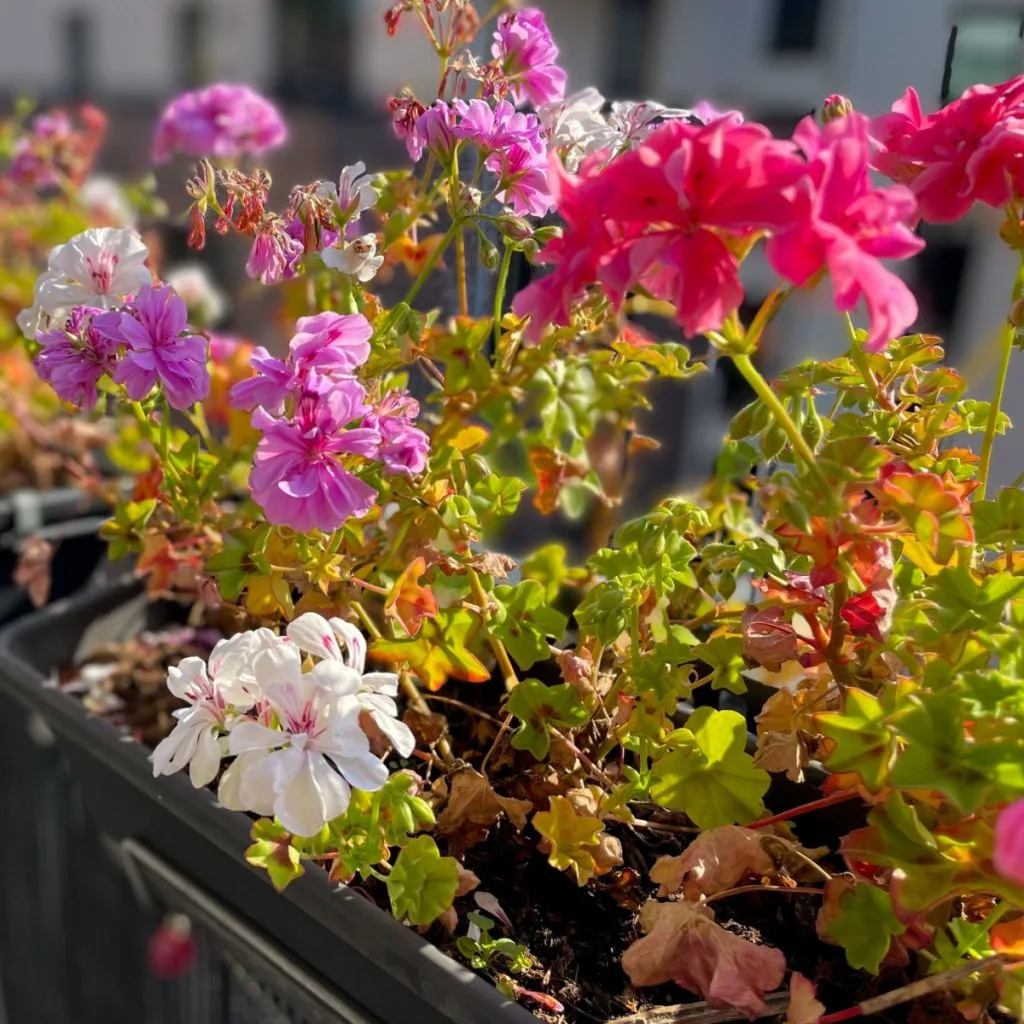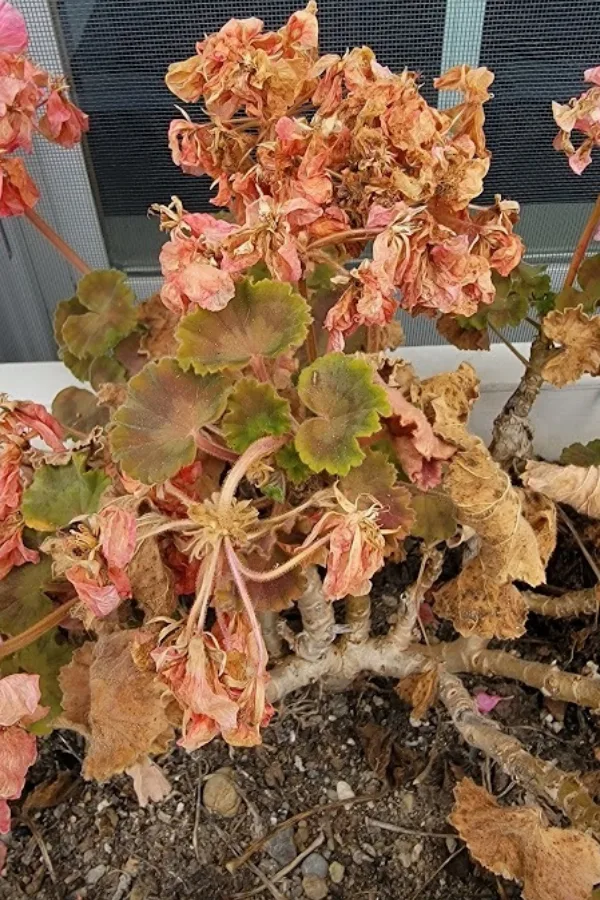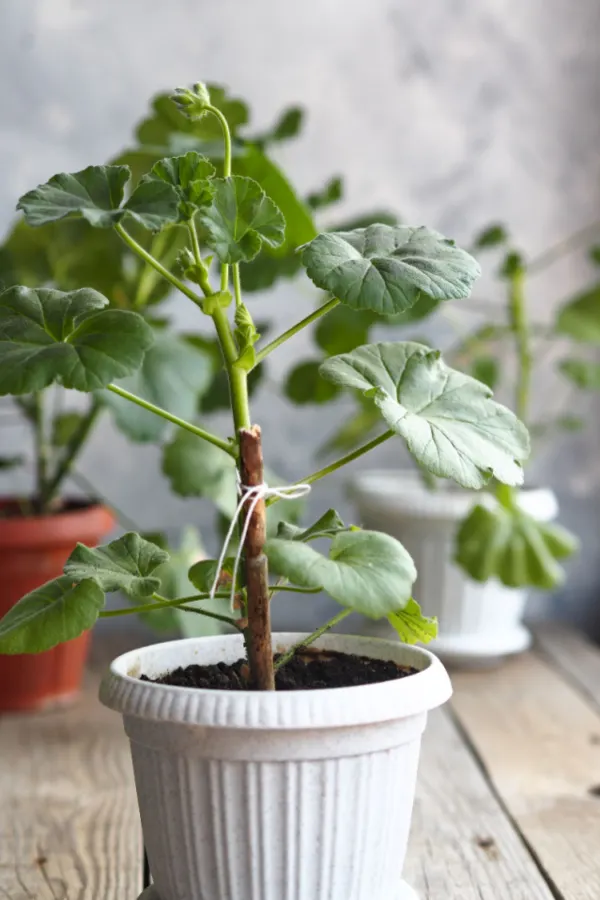Did you that you can save your geraniums this fall and keep them over the winter to grow again next year?
Although geraniums are often thought of as an annual, they are actually a perennial plant in climates with warmer winters. And much as is the case with ferns, with just a little extra effort, they can be brought indoors to overwinter, and then come back the following season add big flower power once again.
The good news is that no matter where you grow your geraniums, whether it be in small containers, large pots, hanging baskets – or even planted directly into bed spaces, you can save them. And let’s face it, with the cost of flowers rising more and more, it’s a great way to save money!

How To Save Geraniums Over The Winter
Saving Your Plants Before It’s Too Late
The first secret to success when saving geraniums is to act early. Unfortunately, once plants are hit by a heavy frost or light freeze, trouble looms. That is because the damage done to their roots usually makes them impossible to save.
Although geraniums are usually tough enough to survive a light frost, once the foliage and blooms freeze, the plant begins to die off. Freezing causes severe damage to the cell structure. Not just to the plant’s leaves and blooms, but more importantly to the roots as well.
Roots are made up of a large percentage of water. When that water freezes and crystalizes, it then ruptures the walls and lining of the roots. And once the root structure is damaged, saving simply is not an option.
With this in mind, early fall is the best time to prepare your geraniums for overwintering. As soon as temperatures begin to dip into the high 40’s or low 50’s in the evening, it’s time to jump into action. Geraniums usually start to fade late in the season anyway, so it’s also a great way to clean up your flowerbeds and containers.

2 Easy Ways To Save Geraniums Over The Winter!
When it comes to saving geraniums, there are two methods to keep them alive over winter. Geraniums growing in pots and containers can actually be brought indoors to grow as a houseplant through the winter. But you can also cut them back and save as a bare root cutting.
Although both methods are simple, selecting the best one really depends on how much space and light you have indoors. It also matters how you are currently growing your geraniums outside. With that in mind, here is an in-depth look at each method, along with some tips for helping your geraniums bounce back with big flower power next spring.
#1. Bringing Geranium Plants Indoors To Save Them Over Winter
If you happen to grow your geraniums in smaller pots, containers or hanging baskets, bringing the plants indoors to continue to grow as a houseplant is a quick and simple method to save them for next year.
The key here is to make sure you have the proper location for growing them as a houseplant. And that means having a space to give them the light and warmth they need.
Geraniums hail from a tropical background. As long as they have plenty of light and can have temperatures close to 70° (F), they will maintain their growth. Mind you, they may not bloom, but they can stay healthy and strong all winter long.

Watering & Winter Care
As for light, placing your geraniums in a southern facing window is best. Southern facing windows provide the best chance of winter sunlight. In addition, make sure to keep them away from cold drafts and heating vents that can dry them out too quickly.
Keep them watered but be careful not to over water. Geraniums suffer more from too much water than not enough. Under normal inside humidity, watering lightly every ten to fourteen days is ideal. If they cannot get enough natural sunlight from a window, a grow light will work wonders for keeping them perky and fresh. Affiliate Link: LED Grow Light,6000K Full Spectrum Clip Plant Growing Lamp.
When bringing potted geraniums indoors, you can also allow them to go dormant. For this, begin by pruning the plant back to around half of its original size. Next, place in a cool, darker area and place a paper bag or burlap over it to keep light out.
An unheated garage or basement usually works well as long as they don’t encounter freezing temperatures. Water your geranium lightly once a month. When spring rolls around, simply bring the plant back outdoors to grow back its foliage once again.
#2. Saving Geraniums As Bare Root Plants
The second method for saving geraniums in the winter is to save them as bare roots. This is great for plants that grew in flowerbeds – or if you happen to be short on space indoors.

To save a bare roots, start by digging up geraniums roots and all. For potted plants you can simply pull the entire plant out of the soil. Cut the top growth down to 1/3rd of its original size. You can cut the plant back prior to digging out to make the process easier.
All you have to do now is store your roots until next year. Place the roots upside down into a cardboard box or a brown paper grocery bag. For storing, place in a cool, dark place that does not freeze.
Next spring, when the temperatures warm, you can plant the bare roots directly into pots or in the ground. In short order, they will spring back to life and fill back out.
Spring Care
Whether saving by bare root or as a houseplant, a little early spring fertilizing will help your geraniums bounce back fast.
Once you take plants back outside, applying a well balanced liquid fertilizer will re-energize the roots. Compost tea, worm casting tea or a commercial liquid fertilizer all work great for providing quick power to the plant.
Liquid fertilizers can absorb into the roots quickly. Although granular fertilizers will work, they will take longer to power up the roots. Continue applying the liquid fertilizer every two weeks for six weeks and your geraniums should be off to the races.
Here is to saving your geraniums over the winter – and saving big money in the process. And if you are looking to save even more this fall, be sure to check out our article: How To Save Coleus In The Fall – Create Great Houseplants & Free Plants For Next Year!
Simple Garden Life
Follow Our Facebook Page For Even More Great Tips! Simple Garden Life Facebook Page
Simple Garden Life is a website dedicated to keeping gardening fun, simple and enjoyable! We publish two new articles each week along with a new garden podcast episode every two weeks. This article may contain affiliate links.
